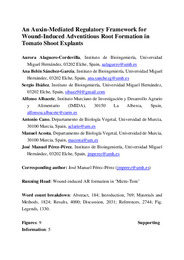Por favor, use este identificador para citar o enlazar este ítem:
https://hdl.handle.net/11000/35297Registro completo de metadatos
| Campo DC | Valor | Lengua/Idioma |
|---|---|---|
| dc.contributor.author | Alaguero Cordovilla, Aurora | - |
| dc.contributor.author | Sánchez García, Ana Belén | - |
| dc.contributor.author | Ibáñez, Sergio | - |
| dc.contributor.author | Albacete, Alfonso | - |
| dc.contributor.author | Cano, Antonio | - |
| dc.contributor.author | Acosta, Manuel | - |
| dc.contributor.author | Pérez Pérez, José Manuel | - |
| dc.contributor.other | Departamentos de la UMH::Biología Aplicada | es_ES |
| dc.date.accessioned | 2025-01-26T09:59:59Z | - |
| dc.date.available | 2025-01-26T09:59:59Z | - |
| dc.date.created | 2021-01-19 | - |
| dc.identifier.citation | Plant, cell and environment Volume44, Issue5 May 2021 Pages 1642-1662 | es_ES |
| dc.identifier.issn | 1365-3040 | - |
| dc.identifier.issn | 0140-7791 | - |
| dc.identifier.uri | https://hdl.handle.net/11000/35297 | - |
| dc.description.abstract | Adventitious roots (ARs) are produced from non-root tissues in response to different environmental signals, such as abiotic stresses, or after wounding, in a complex developmental process that requires hormonal crosstalk. Here, we characterized AR formation in young seedlings of Solanum lycopersicum cv.‘Micro-Tom’ after whole root excision by means of physiological, geneticand molecular approaches. We found that a regulated basipetal auxin transport from the shoot and local auxin biosynthesis triggered by wounding are both required for the re-establishment of internal auxin gradients within the vasculature. This promotes cell proliferation at the distal cambium near the wound in well-defined positions of the basal hypocotyl and during a narrow developmental window. In addition, a pre-established pattern of differential auxin responses along the apical-basal axis of the hypocotyl and an as of yet unknown cell-autonomous inhibitory pathway contribute to the temporal and spatial patterning of the newly formed ARs on isolated hypocotyl explants. Our work provides an experimental outline for the dissection of wound-induced AR formation in tomato, a species that is suitable for molecular identification of gene regulatory networks via forward and reverse genetics approaches. | es_ES |
| dc.format | application/pdf | es_ES |
| dc.format.extent | 60 | es_ES |
| dc.language.iso | eng | es_ES |
| dc.publisher | Wiley | es_ES |
| dc.rights | info:eu-repo/semantics/openAccess | es_ES |
| dc.rights | Attribution-NonCommercial-NoDerivatives 4.0 Internacional | * |
| dc.rights.uri | http://creativecommons.org/licenses/by-nc-nd/4.0/ | * |
| dc.subject | solanum lycopersicum | es_ES |
| dc.subject | cell reprogramming | es_ES |
| dc.subject | auxin biosynthesis | es_ES |
| dc.subject | polar auxin transport | es_ES |
| dc.subject | de novo root formation | es_ES |
| dc.subject | auxin response | es_ES |
| dc.subject | hormone regulation | es_ES |
| dc.subject | mechanical damage | es_ES |
| dc.subject | adventitious rooting | es_ES |
| dc.subject | tissue regeneration | es_ES |
| dc.subject.other | CDU::5 - Ciencias puras y naturales::57 - Biología | es_ES |
| dc.title | An Auxin-Mediated Regulatory Framework for Wound-Induced Adventitious Root Formation in Tomato Shoot Explants | es_ES |
| dc.type | info:eu-repo/semantics/article | es_ES |
| dc.relation.publisherversion | https://doi.org/10.1111/pce.14001 | es_ES |

Ver/Abrir:
2021_Alaguero-Cordovilla_PCE.pdf
3 MB
Adobe PDF
Compartir:
 La licencia se describe como: Atribución-NonComercial-NoDerivada 4.0 Internacional.
La licencia se describe como: Atribución-NonComercial-NoDerivada 4.0 Internacional.
.png)